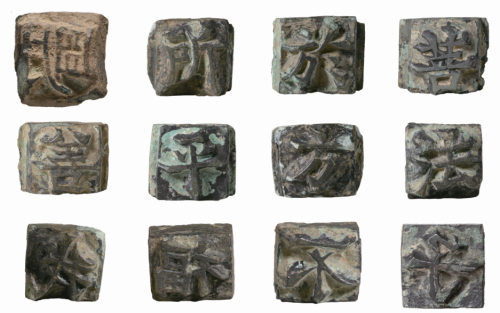Ink stains on movable metal print types, claimed to be the world’s oldest, have been scientifically shown to be from the Goryeo Kingdom of Korea (918 ― 1392), Hong Wan, a scholar from Korea Institute of Geoscience and Mineral Resources, said on Saturday.
Hong, speaking at a forum organized by the Institute for Social Science Research of Kyungpook National University and Cheongju Early Printing Museum, in central Seoul, said he reached the conclusion based on the testing of seven metal blocks’ stained ink. The seven blocks had more ink stains than others, he said.
Hong’s research supports Kyungpook National University professor Nam Kwan-heui’s claim last year that the metal types predate “Jikji,” the UNESCO-designated Korean document that is currently regarded as the world’s oldest extant book printed with movable metal types, by 138 years.
The Kyungpook National University professor had been researching the print type blocks, also named “Jeungdoga-Ja,” at the request of Dabosung Antique, an antique gallery located in Insa-dong, Seoul.
Researchers at the National Museum of Korea last year said it would be difficult to confirm the year of origin of the metal blocks, as metal relics, unlike wooden ones, lack carbon crucial for the carbon dating process.
 |
Twelve movable metal print types that are claimed to be the oldest of their kind. (Yonhap News) |
And that is why Hong used the blocks’ stained ink, instead of the blocks themselves, as the main source of his research.
“Because ‘Jeuengdoga-Ja’ blocks are made of metal, it was impossible to get carbon substance out of them,” Hong told reporters.
According to Hong’s research, the ink stain on a block with a Chinese letter “bi” turned out to have a 95.4 percent possibility of being made sometime between the year 1160 and 1280. An ink stain on a block with a letter “bul” showed 95.4 percent possibility of belonging to sometime from 1010 to 1210.
Ink from another block with the letter “dae” showed a 94 percent possibility of belonging to a year from 770 to 980, while ink stain on a block with the letter “in” had a 95.4 percent chance of being made sometime between the year 810 to 1030.
“The research was based on the stained ink, and that’s why the result does not necessarily indicate the exact year of origin of the blocks,” Hong said. “To be more precise, our research result represents the year when the ink’s main ingredient ― trees from the Goryeo Dynasty ― died.”
Hong also pointed out that each block’s stained ink may have shown different years of origin depending on which part of a tree was used to make the pigmented liquid.
Last year, a KBS 1TV show “History Special” also requested KIGAM and a Japanese institution to examine the stained ink on the blocks, while featuring the metal types. Both institutions concluded that the stained ink on the blocks have a high possibility of having been made during the Goryeo Dynasty.
During the forum, Hong was asked if the same result would be found by obtaining the Goryeo Dynasty ink from somewhere else and applying it to the metal blocks.
“It is possible (to get the same result),” Hong answered.
If “Jeungdoga-Ja“ blocks are confirmed to be the world’s oldest movable metal type, they will rewrite history. According to Dabosung Antique, the blocks are believed to have been taken to Japan during the colonial era. An unidentified private individual purchased the types and brought them back to Korea about 10 years ago. The name of the individual and how she or he obtained the blocks are still unknown.
By Claire Lee (
dyc@heraldcorp.com)





![[Exclusive] Hyundai Mobis eyes closer ties with BYD](http://res.heraldm.com/phpwas/restmb_idxmake.php?idx=644&simg=/content/image/2024/11/25/20241125050044_0.jpg)
![[Herald Review] 'Gangnam B-Side' combines social realism with masterful suspense, performance](http://res.heraldm.com/phpwas/restmb_idxmake.php?idx=644&simg=/content/image/2024/11/25/20241125050072_0.jpg)

